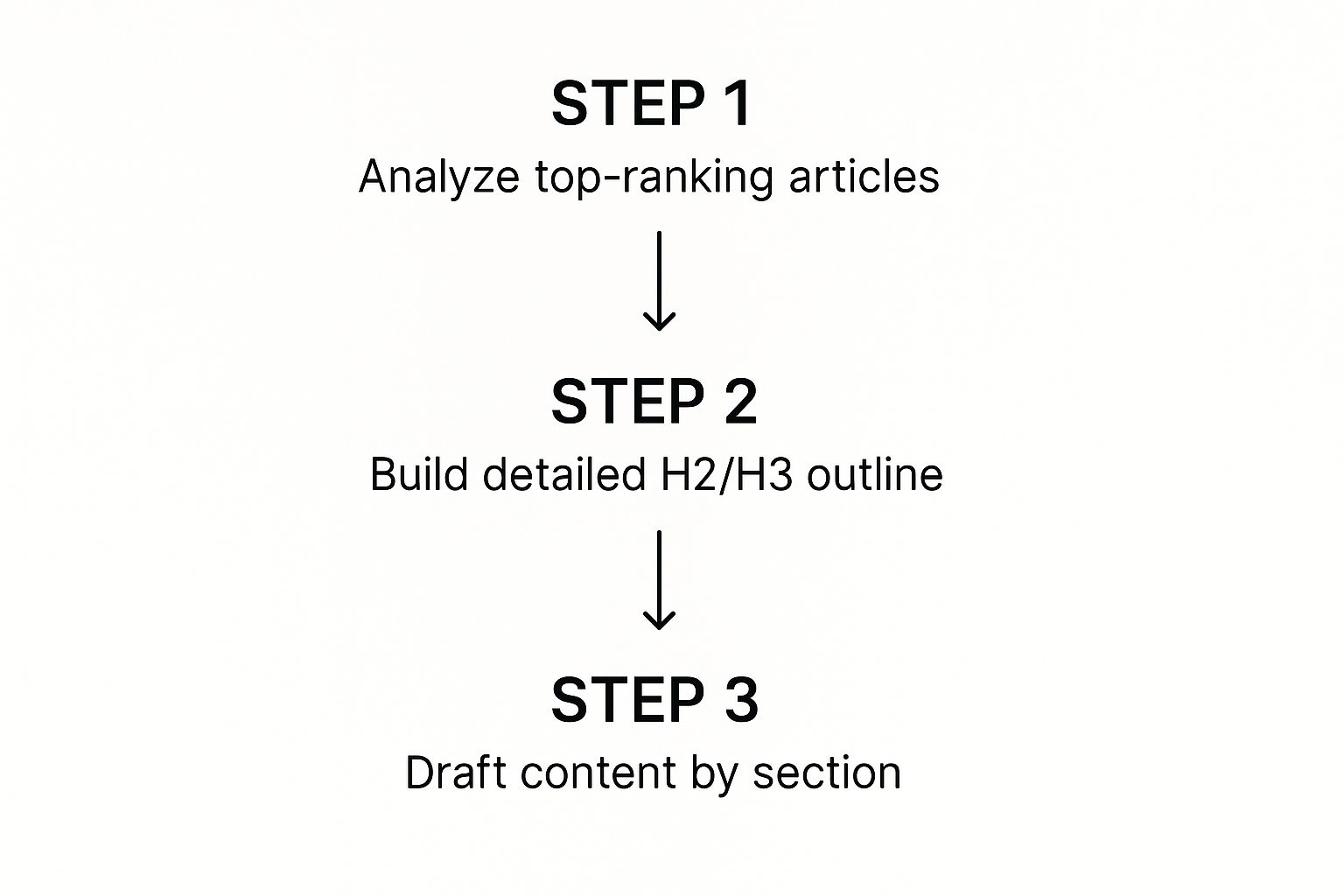How to Write Blog Posts Faster and Better
Learning how to write blog posts faster doesn't have to mean sacrificing quality. The real secret is building an efficient, repeatable system that gets you past the usual friction points—like writer's block and the endless cycle of edits. It's about creating better content in a fraction of the time.
Moving Past the Speed vs. Quality Dilemma

Every content creator I know feels the pressure to publish consistently without the quality dipping. It’s a tough balancing act. The goal isn't just about "writing faster," though. It's about becoming more efficient. This guide is all about reframing that challenge from a race against the clock to a strategic overhaul of your entire workflow.
This isn’t about cutting corners. It’s about building a smarter system—using proven methods like detailed outlining, batching similar tasks, and bringing in modern tools to slash the time you spend drafting and editing. When you focus on the process, you eliminate the mental drag that really slows you down.
Why Efficient Content Creation Matters
The need for both speed and quality has never been more critical. The blogosphere is enormous—hundreds of millions of blogs exist—and blogging remains central to content marketing. Numerous surveys show a large share of B2B buyers read blog content during research, so the takeaway is clear: consistency and quality win.
To actually stand out, you need a system that delivers both volume and value. A well-oiled workflow lets you:
- Maintain Consistency: Publishing on a reliable schedule keeps your audience engaged and builds your authority over time.
- Improve Quality: When you're not bogged down by tedious tasks, you free up mental energy to focus on what matters: creating insightful, well-researched content.
- Increase Output: You can produce more content in the same amount of time, which expands your reach and overall impact.
The secret to faster writing isn’t about typing more words per minute. It's about reducing the time spent staring at a blank page, rethinking structure, and making endless revisions.
Ultimately, a streamlined process gives you back your most valuable asset: time. You can then reinvest that time into other crucial areas like promotion, strategy, and actually connecting with your audience. Let's get into the practical steps to build that system.
Core Strategies for Efficient Blog Writing
Here’s a quick look at the core methods for improving writing speed without compromising quality, which we'll explore in detail.
| Strategy Pillar | Primary Benefit | Potential Time Saved |
|---|---|---|
| Preparation & Outlining | Eliminates writer's block and ensures a logical flow from the start. | Can save significant drafting time |
| Task Batching | Minimizes context switching to maintain deep focus on one activity. | Reduces friction across the process |
| Tool Integration | Automates repetitive tasks like research, grammar checks, and formatting. | Speeds up editing & polishing |
| Focused Drafting | Separates the writing and editing phases to encourage momentum. | Cuts initial writing time noticeably |
These pillars form the foundation of a highly effective content creation engine. By mastering each one, you'll see a dramatic improvement in both your speed and the final quality of your work.
Create a Powerful Outline Before You Type
Ever stare at a blinking cursor on a blank page? It’s a total momentum killer. The fastest way to get lost when writing a blog post is to start without a map. A detailed, SEO-informed outline is that map—it guides every sentence and saves you from that dreaded creative paralysis.
This isn't about scribbling down a few vague bullet points. I'm talking about building the complete skeleton of your article before you even think about writing the first paragraph. When you do this, the writing process completely changes. It stops being a massive creative hurdle and becomes more like a simple fill-in-the-blanks exercise. The heavy lifting—the thinking, the structuring, the keyword strategy—is already done.
This infographic breaks down a simple three-step process for building an outline that will seriously speed up your writing.

As you can see, the analysis and structuring have to happen before you start drafting. That's the secret to getting both speed and quality.
How to Build a Better Outline
So, what does a truly helpful outline look like? It’s a lot more than just a list of topics. You're aiming to create a comprehensive blueprint for your entire article.
My own process for a competitive post always starts with research. I'll pull up the top-ranking articles for my target keyword and break them down. What are their main sections? What questions are they answering? And, critically, what did they miss? This is where you find your opportunity to stand out.
An outline is more than a list of topics; it's a strategic document that defines the user's journey, integrates keywords naturally, and engineers a better, more comprehensive article than your competitors.
From that analysis, I build an outline designed to be the most thorough resource on the web. It usually includes:
- Main H2 Headings: These are the big, core subtopics of the article.
- Supporting H3 Headings: I use these to break down each H2 into more specific points or actionable steps.
- Key Talking Points: Under each heading, I'll drop in quick notes, stats I want to include, or examples I plan to use.
- Keyword Placement: I map out exactly where my primary and secondary keywords will fit naturally within the headings and the body copy.
Having this level of detail means that when I sit down to write, I’m not hunting for stats or wrestling with the article's flow. I’m just fleshing out the points I’ve already laid out. It makes the whole process faster and way less stressful.
Embrace a Task Batching Workflow

If you're constantly bouncing between researching, writing, and editing, you're killing your own productivity. Seriously. The mental whiplash from switching between the creative zone of drafting and the analytical mindset of editing is a huge energy drain. This is where task batching can completely change the game for you.
Instead of wrestling one blog post from start to finish, the idea is to group similar tasks together and knock them all out in one dedicated block of time. It's like an assembly line for your content. Your brain gets to stay in one mode, helping you find that elusive "flow state" that multitasking absolutely shatters.
How to Structure Your Week with Batching
So, what does this look like in the real world? Let's say you have a goal of publishing four blog posts this month. Rather than chipping away at them one by one, you could organize your week this way:
- Monday Morning (Research Block): Carve out a few hours to dive deep into research for all four articles. You’re in full-on investigator mode—finding keywords, digging up stats, and checking out what competitors are saying.
- Monday Afternoon (Outlining Block): With all that fresh research swimming in your head, transition to architect mode. Spend the afternoon creating detailed outlines for each of the four posts. This is where you map out your arguments and structure.
- Tuesday & Wednesday (Drafting Days): Now it's time to just write. Don't worry about perfect grammar or finding the right image yet. Just get the words on the page. Aim to draft two full articles each day while you're in creator mode.
- Thursday (Polish & Visuals): Switch gears to editor mode. This is when you'll review and polish all four drafts. Fix typos, tighten up sentences, and create or source all the graphics and images you need.
By focusing on one type of task at a time, you cut down on the mental friction that slows you down.
This isn't about working harder; it's about working smarter. Batching lets you maintain a much deeper level of focus, which naturally results in higher-quality work done in way less time.
This approach brings a sense of calm and order to what can often feel like a chaotic process. You’ll find you can produce content faster and more predictably without feeling so scattered.
Get Your First Draft Down Faster with Smart Tech
Let's be honest, for a lot of us, the real bottleneck isn't finding ideas—it's the slow, tedious process of typing them out. Your brain is firing on all cylinders, but your fingers just can't keep up. This is where a little bit of smart tech can completely change the game, helping you get your thoughts onto the page as quickly as they come to you.
The goal at this stage isn't to create a masterpiece. It's to produce what I call a "messy first draft." Think of it as a block of clay; you just need to get all the raw material in one place before you can start shaping and refining it. Getting this draft done is often the hardest part, so let's make it easier.
Talk, Don't Type, Your First Draft
One of the best things I ever did for my writing speed was to stop typing and start talking. I use speech-to-text tools to dictate my initial draft, and it’s often several times faster than pecking away at a keyboard.
Consider this: the average person talks at about 150 words per minute, but the average typing speed is a mere 40 words per minute. It's simple math.
This approach has a hidden benefit, too. It helps you silence that pesky inner editor who questions every single word you type. You just speak your mind, letting the ideas flow naturally without getting hung up on perfect grammar or sentence structure. It's a much more fluid way to capture what you know.
Your messy first draft is not a reflection of your final product. Its only job is to exist. Using speech-to-text gets it onto the page with maximum speed and minimal friction.
If you're looking for a powerful tool that respects your privacy, see how a tool like Paraspeech can help you draft content quickly across all your Mac applications.
Let AI Be Your Writing Partner
Beyond just getting words down, AI writing assistants can be an incredible partner during the drafting phase. They're great for getting you past those little roadblocks that can grind your progress to a halt.
Here are a few ways I use them:
- Busting Through Writer's Block: If I'm stuck on how to start a new section, I'll ask an AI to give me a few opening sentences. It's often just the spark I need to get going again.
- Fixing Clunky Sentences: We all write them. When a sentence just feels off, I can have an AI rephrase it in a few different ways in seconds.
- Quick Grammar Checks: A quick pass for glaring errors helps make the messy draft readable enough for me to start editing.
This shift toward smarter drafting seems to be a wider trend. The average time to write a blog post has dropped to 3 hours and 48 minutes, which I suspect is partly due to writers adopting more efficient workflows with tools like these.
Of course, speed isn't everything. As benchmarks from Orbit Media show, bloggers who spend 6+ hours on a post often report better results. The key is to use technology to speed up the drafting, which frees up more of that crucial time for the deep editing and polishing that truly makes a post shine.
Give Your Draft Room to Breathe
 You've just banged out a first draft. The temptation to immediately dive back in and start "fixing" things is huge, but it's also the biggest mistake you can make. You're still way too close to the words to see what's actually on the page.
You've just banged out a first draft. The temptation to immediately dive back in and start "fixing" things is huge, but it's also the biggest mistake you can make. You're still way too close to the words to see what's actually on the page.
The first rule of effective editing is simple: walk away. Seriously. Give yourself at least a few hours, or better yet, a full day. This mental space is what gives you the fresh eyes needed to spot clunky sentences, logical gaps, and awkward phrasing you were blind to before.
When you do come back, don't try to fix everything at once. That's a recipe for a long, painful slog. Instead, a systematic approach turns editing into a quality check, not a rescue mission. Breaking it down into distinct passes makes the whole thing faster and much more effective.
The Three-Pass Editing Framework
I’ve found the best way to edit methodically is to tackle it in three focused stages. Each pass has one clear goal, which stops you from getting sidetracked by a typo when you should be looking at the overall flow. This structured approach is a game-changer for finishing blog posts quickly and confidently.
Here’s how I break it down:
-
Pass 1: The Big-Picture Edit. First, just read. Don't touch a single comma. You're looking at the structure and flow. Does the intro grab you? Do the sections connect naturally? This is the time to move entire paragraphs, axe a section that doesn't work, or rewrite your conclusion for more punch.
-
Pass 2: The Sentence-Level Edit. Now you can zoom in. The goal here is to tighten everything up. Hunt down repetitive words, swap out weak verbs for stronger ones, and simplify sentences that ramble on. This is where you cut the fluff.
I find that cutting 10-15% of a draft’s word count almost always makes it stronger. It forces clarity and gives your message more impact.
- Pass 3: The Final Polish. This last pass is your final line of defense against any embarrassing slip-ups. I always run my text through tools like Grammarly and the Hemingway App to catch grammar goofs, spelling errors, and typos. Automating these final checks frees you up to give the content one last read-through. If you ever hit a snag with our own tools, you can usually find quick answers in the Paraspeech support documentation.
Frequently Asked Questions About Speeding Up Your Blog Writing
When you start looking for ways to write blog posts faster, a few questions always seem to pop up. The biggest one? People worry that moving faster automatically means sacrificing quality. I get it, but it's a total myth.
The whole point isn't just about raw speed—it's about becoming more efficient. Think about it: when you use smart tactics like creating a rock-solid outline, batching your tasks, and drafting in focused bursts, you're just optimizing the mechanical stuff. This actually leaves you with more brainpower to pour into what really matters: your ideas, your research, and making that final draft shine. It’s a classic case of working smarter, not harder.
So, How Long Should It Actually Take to Write a Blog Post?
Once you get a rhythm going with these techniques, you'll be surprised. Many writers I know can consistently crank out a high-quality, 1,500-word post in about two to three hours. That time covers everything from the initial outline to the final proofread.
Of course, your first few tries might feel a bit clunky as you're building new habits. Stick with it. The time you'll save in the long run is massive.
Here's the real secret: treat AI as your creative partner, not a replacement. Let it toss around ideas with you, sharpen a clunky sentence, or even generate a rough first draft to get you unstuck. Your personal expertise and unique voice are what build a loyal audience—AI is just there to give them a megaphone.
For more deep dives into building a killer content workflow, you should check out the articles on the Paraspeech content creation blog.



